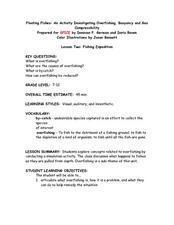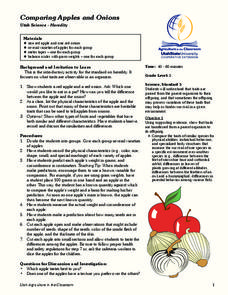American Museum of Natural History
Microbes Coloring Book and Scavenger Hunt
Coloring pages showcase microbes—bacteria, viruses, and protists. Scholars have the option to download a coloring book and scavenger hunt or color the page directly on the computer. Three paragraphs describe each microbe.
Berkshire Museum
Camouflage!: Collecting Data and Concealing Color
Help young scholars see the important role camouflage plays in the survival of animals with a fun science lesson. Starting with an outdoor activity, children take on the role of hungry birds as they search for worms represented by...
Curated OER
Pre-School
Students draw their hand, and color their drawing. They count the number of fingure on thier hand. Students count the number of arms on the marine animal in the picture. They count the number of legs and claws on the marine animal in the...
Curated OER
All About Seeds!
How do fruits relate to flowers and seeds? Identify the seeds and their purpose with a coloring activity for kindergartners. Once they color the seeds of apples, bananas, and peas (among others), kids get hands-on experience with bean...
Resources for Educators
Math & Science Connection
Whether you're using a collection of Dr. Seuss books to teach basic math skills like counting, adding, and subtracting, or exploring the different states of matter by melting a crayon with a hairdryer, a series...
Curated OER
Name that animal
A great way to classify organisms, is by counting the number of legs it has or how it moves. Little ones count the legs on five different creatures, then match the leg count to the proper animal name. Tip: Have them come up with other...
Curated OER
Seeds in Fall...Collect Them All!
Classify seeds by attributes such as size, shape and color! Learners classify seeds using a dichotomous key. They identify human behaviors that have a positive impact on preserving seed and plant biodiversity.
Curated OER
Trace the Sun
In this tracing worksheet, students first trace the rays around the sun and then color the entire picture. Students also count the number of points that each ray represents.
Curated OER
Fish Activities
In this fish activity worksheet, pupils learn a counting rhyme about fish. They then discuss the best way to care for fish and they learn 4 different types of fish. On the second page, students count lines of fish and color them a...
WakeGOV
Plastic Sight Words
Plastic math? Have young learners count and name the number of plastic items in their centers. Kindergartners match sight word cards to the number of plastics in a given group, while learning that plastics come in all different shapes,...
Alabama Learning Exchange
Yummy Apples!
Young learners listen to a read aloud of Gail Gibbons book, Apples and the story A Red House With No Windows and No Doors. They compare characteristics of a number of kinds of apples, graph them and create a apple print picture. Learners...
Curated OER
Who Lives with Mallard?
Students color a picture of the habitat featuring mallard and other creatures, some of whom might be camouflaged or half-hidden. They discuss other forms of animal adaptation.
Curated OER
Rocks
Students examine and classify various types of rocks. In this rock identification lesson, students complete a KWL chart about rocks and then read Let's Go Rock Collecting. Students go on a walk to collect rocks and then...
Curated OER
Sorting Gourds
Students discover different types of gourds. In this plant comparison lesson, students compare and contrast several types of gourds based on shape, color and texture. Students observe a video clip based on sorting gourds.
Curated OER
Gummy Bear Sorting
Students demonstrate knowledge of sorting and classifying by color as they sort gummy bear candies.
Curated OER
Body Parts in Spanish
Students use Spanish to recognize and recall body parts. In this Spanish anatomy lesson plan, students identify and name the parts of the body in Spanish. Students describe a person physically by his hair and color of eyes. Students...
Curated OER
Tomato Exploration
Create tomatoes in 15-20 minutes using this fun and interactive lesson plan! Learners listen to a book about tomatoes (recommendations listed), and focus on the vocabulary word tomato. They count the syllables...
Curated OER
Fun with Flowers
Students make observations of flowers. In this life science lesson, students look at flowers, then draw and color their favorite flowers. Lesson includes extension activities.
Curated OER
Look At Those Leaves!
Students sort tree leaves. For this plant biology lesson, students collect leaves and group them according to size, shape, and color. Students discuss their observations.
Curated OER
Floating Fishes: Fishing Expedition
A referenced PowerPoint is not included, but this lesson plan can still make an impact with emerging environmentalists. After introducing them to the facts about overfishing, they experiment with a fishing simulation using colored beads...
Curated OER
Investigating Different Rock Types
Learners analyze a rock using their eyes and then a hand lens. In this science lesson, students determine and discuss how hard or how easy it was to find and classify the assigned rock. Learners record their observations on an index...
Curated OER
Crystals
Students investigate crystal formation, their shapes and the best places to cleave crystals for smooth edges. In this crystal lesson plan, students experiment to form crystals with Salol as well as with copper wire and Silver Nitrate....
Curated OER
Comparing Apples and Onions
Fifth graders observe and compare apples. In this apples lesson, 5th graders work in groups to record the physical characteristics of a variety of apples. Students predict each apples weight and then weigh them to see if they were...
Curated OER
The Spider's Life Cycle
Students see that spiders have a life cycle, and reproduce by laying many eggs. We can count by ones, twos, fives, or as many as we want. They make two lists of animals on a chart.























